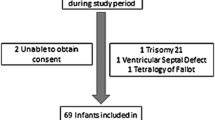Abstract
The aim of this study was to investigate differences in amino-terminal proB-type natriuretic peptide (NT-proBNP) levels in the cord blood of neonates according to the type of congenital heart disease (CHD) and to evaluate the usefulness of NT-proBNP as a prognostic marker. We included 76 neonates with prenatally diagnosed CHD and 45 controls without CHD. Neonates were classified into five groups based on echocardiographic findings. The levels of NT-proBNP in the cord blood were examined and analyzed according to the neonatal outcomes. The levels of NT-proBNP were significantly elevated in the cord blood of neonates with CHD compared with that in the cord blood of controls. The levels of NT-proBNP in the group with right ventricular outflow tract obstruction without a ventricular septal defect were significantly increased compared to that in the other groups. The neonates that required acute surgical correction had higher levels of NT-proBNP in the cord blood, though they were not statistically significant. Meanwhile, NT-proBNP levels in the cord blood of neonates with functional single ventricle were significantly higher than that in the cord blood of those with functional biventricles. Significant differences in the levels of NT-proBNP between survivors and nonsurvivors were observed within 1 year of birth. In this study, we found that the levels of NT-proBNP in the cord blood of neonates with CHD were higher than the levels in controls. This finding was striking in the group with right ventricular outflow tract obstruction, and it was associated with surgery for functional single ventricle and 1-year survival.


Similar content being viewed by others
References
Eerola A, Jokinen E, Sairanen H, Pihkala J (2010) During treatment protocol for univentricular heart serum levels of natriuretic peptides decrease. Eur J Cardiothorac Surg 38:735–740
Eindhoven JA, van den Bosch AE, Jansen PR, Boersma E, Roos-Hesselink JW (2012) The usefulness of brain natriuretic peptide in complex congenital heart disease: a systematic review. J Am Coll Cardiol 60:2140–2149
Eindhoven JA, van den Bosch AE, Boersma E, Roos-Hesselink JW (2013) The usefulness of brain natriuretic peptide in simple congenital heart disease—a systematic review. Cardiol Young 23:315–324
El-Khuffash A, Molloy EJ (2007) Are B-type natriuretic peptide (BNP) and N-terminal-pro-BNP useful in neonates? Arch Dis Child Fetal Neonatal Ed 92:320–324
Garofoli F, Mannarino S, Montanari L, Cerbo R, Tzialla C, Mazzucchelli I et al (2012) Variation of B-type natriuretic peptide concentrations and intrauterine growth restriction: mother, fetus and newborn. J Biol Regul Homeost Agents 26:733–739
Hall C (2005) NT-ProBNP: the mechanism behind the marker. J Card Fail 11:S81–S83
Holmgren D, Westerlind A, Berggren H, Lundberg PA, Wahlander H (2008) Increased natriuretic peptide type B level after the second palliative step in children with univentricular hearts with right ventricular morphology but not left ventricular morphology. Pediatr Cardiol 29:786–792
Kanbe T, Maeno Y, Fujino H, Kanda H, Hirose A, Okada J et al (2009) Brain-type natriuretic peptide at birth reflects foetal maturation and antenatal stress. Acta Paediatr 98:1421–1425
Lechner E, Schreier-Lechner EM, Hofer A, Gitter R, Mair R, Biebl A et al (2009) Aminoterminal brain-type natriuretic peptide levels correlate with heart failure in patients with bidirectional Glenn anastomosis and with morbidity after the Fontan operation. J Thorac Cardiovasc Surg 138:560–564
Lechner E, Wiesinger-Eidenberger G, Wagner O, Weissensteiner M, Schreier-Lechner E, Leibetseder D et al (2009) Amino terminal pro B-type natriuretic peptide levels are elevated in the cord blood of neonates with congenital heart defect. Pediatr Res 66:466–469
Merz WM, Kubler K, Albers E, Stoffel-Wagner B, Gembruch U (2010) Reference values for N-terminal pro-B-type natriuretic peptide in fetal circulation between 20 and 34 weeks of gestation. Clin Biochem 43:519–521
Merz WM, Kubler K, Albers E, Stoffel-Wagner B, Gembruch U (2012) N-terminal pro-B-type natriuretic peptide in the circulation of fetuses with cardiac malformations. Clin Res Cardiol 101:73–79
Pietrzak R, Werner B (2009) Usefulness of NT-proBNP in assessment of right ventricular function in children after tetralogy of Fallot correction—a preliminary study. Kardiol Pol 67:378–383
Schaefer A, Tallone EM, Westhoff-Bleck M, Klein G, Drexler H, Rontgen P (2010) Relation of diastolic and systolic function, exercise capacity and brain natriuretic peptide in adults after Mustard procedure for transposition of the great arteries. Cardiology 117:112–117
Seong WJ, Yoon DH, Chong GO, Hong DG, Koo TB, Lee TH et al (2010) Umbilical cord blood amino-terminal pro-brain natriuretic peptide levels according to the mode of delivery. Arch Gynecol Obstet 281:907–912
Seong WJ, Kim SC, Hong DG, Koo TB, Park IS (2011) Amino-terminal pro-brain natriuretic peptide levels in hypertensive disorders complicating pregnancy. Hypertens Pregnancy 30:287–294
Walker SG, Stuth EA (2004) Single-ventricle physiology: perioperative implications. Semin Pediatr Surg 13:188–202
Wu MH, Chen HC, Lu CW, Wang JK, Huang SC, Huang SK (2010) Prevalence of congenital heart disease at live birth in Taiwan. J Pediatr 156:782–785
Acknowledgments
This research was supported by Kyungpook National University Research Fund, 2014.
Author information
Authors and Affiliations
Corresponding author
Ethics declarations
Conflict of interest
There is no conflict of interest in this article.
Rights and permissions
About this article
Cite this article
Bae, J.Y., Cha, HH. & Seong, W.J. Amino-Terminal proB-Type Natriuretic Peptide Levels in the Umbilical Cord Blood of Neonates Differ According to the Type of Prenatally Diagnosed Congenital Heart Disease. Pediatr Cardiol 36, 1742–1747 (2015). https://doi.org/10.1007/s00246-015-1228-z
Received:
Accepted:
Published:
Issue Date:
DOI: https://doi.org/10.1007/s00246-015-1228-z




